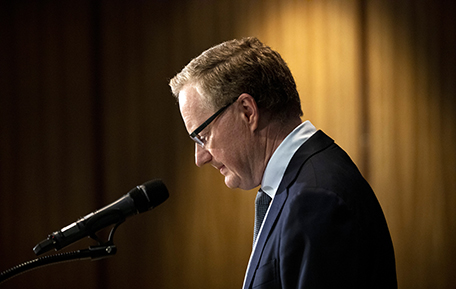Debt, deficits and minimising economic ‘scars’
Westpac chief economist Bill Evans discusses the government’s economic and fiscal update.
After months of knowing “eyewatering” government debt and deficit numbers were inevitable, this week they became reality.
Treasurer Josh Frydenberg yesterday confirmed COVID-19 had turned previously expected budget surpluses into the largest deficits since World War II – $85.8 billion in 2019-20 and $184.5bn this financial year. In turn, net debt is penciled in to rise from $488bn to $677bn, or 35.7 per cent of GDP, in June 2021 as gross debt lifts to $852bn, headline-grabbing levels the Treasurer conceded would take a “number of years” to pay back.
"These are daunting figures," he told the National Press Club in Canberra today.
Bill Evans, Westpac's chief economist, says while this year’s deficit actually came in below his expectations, fairly “optimistic” assumptions had been made about the easing of coronavirus restrictions and the government would likely unveil more spending and stimulus in the final October budget, pushing the deficit closer to his forecast of more than $200bn. He says this would be good for the bruised economy and not overly burden future generations.
“Debt levels have increased materially associated with the budget deterioration,” he says. “That said, they remains at levels below many other advanced nations and at levels arguably still manageable in an environment of ultra-low interest rates – with the 10 year government bond trading below 1 per cent currently, a rate below the nation’s medium-term growth potential.”
In the near term, however, Treasury – along with all economists – isn’t tipping a lot of growth.
Real GDP shrinks 2.5 per cent this financial year, following a 0.25 per cent decline in 2019-20 – a rare two consecutive years of contraction. As for jobs, the unemployment rate would peak at 9.25 per cent in the coming December quarter, up from 7.4 per cent today, before easing to 8.75 per cent by mid next year, the government predicted.
For many economists, it’s this final issue that’s of greatest concern given the “scarring” that downturns and extended unemployment bring.
In a speech this week, Reserve Bank of Australia Governor Philip Lowe warned about economic scars, saying history showed they were more severe the deeper and more protracted downturns are. He said they often occurred through younger people “not getting onto the jobs ladder, or slipping off it, with permanent effects on their lives” and people losing training opportunities that have long-term impacts on their careers.
“We need to do what we can to limit the severity of these costly scars. These scars have long-term effects and they damage our society and our economy,” Dr Lowe said. “The government can play an important role here by using its balance sheet to smooth things out and reduce the severity of the downturn. In doing so, it helps not only in the present but in the future as well.”

RBA Governor Philip Lowe says economic scars damage society and the economy. (Getty)
On Tuesday, the government unveiled a further $20bn of spending – taking total fiscal and “balance sheet” support to $289bn – via extensions to the $70bn JobKeeper wage subsidy scheme and the JobSeeker supplement for the unemployed.
With JobKeeper, businesses will have to meet the revenue test each quarter and the payment will be lowered from $1500 a fortnight to $1200 in the December quarter ($750 for part-time workers doing less than 20 hours a week) and $1000 and $650, respectively, in the March quarter, at a cost of $16bn. The numbers of Australians on the scheme is tipped to slide from 3.5 million to 1.4 million in the December quarter, then down to 1 million for the remaining three months. Meanwhile, the $550 JobSeeker supplement will fall to $250 in the December quarter at a cost of $3.8bn.
While economists backed the extensions, Mr Evans noted that injections into the economy from government policies will still fall to $13.5bn in the December quarter, down from $65bn and $95bn in the June and September quarters, respectively.
“Without doubt, the economy will have to adjust to a very large reduction in government support in the December quarter placing extraordinary reliance on a sustained opening up of the economy during that time,” he said this week.
But as Mr Evans has previously pointed out, a major longer term concern once initial shocks pass is how long it takes to bring unemployment down.
Following the early 1980s recession, it took six years for the unemployment rate to get back to pre-recession levels, and a longer 15 years in the wake of the early 90s recession. In today’s coronavirus crisis, the “effective” unemployment rate – which includes people on the JobKeeper wage subsidy working zero hours and those who have left the workforce – is already 11.3 per cent, according to the government. Adding the official underemployment rate – those with a job who want more hours – of 11.7 per cent puts so-called “real” underutilisation at more than 20 per cent, a record high.
Meanwhile, youth unemployment is at 20-year highs.
“The labour market is, perhaps, the most pertinent economic and social indicator of a recession," Westpac senior economist Justin Smirk wrote for Westpac Wire this week. “It’s the strength of employment once JobKeeper eventually ends that’s the key to how this recession plays out.”
In a discussion paper late last year for the US Federal Reserve, researchers found consumers who had lived through periods of high unemployment “exhibit persistent pessimism about their future financial situation and spend significantly less”. On the bright side, this “experience-induced frugality” resulted in scarred consumers building up more wealth over time. However, the uncertainty ahead is whether the same positive wealth impacts occur again given the boost to asset prices and growth from falling interest rates that has occurred in the past isn’t possible this time around, with central banks having already cut to zero or thereabouts.
In addition, higher debt may ultimately drag, Morgan Stanley strategists this week estimating global debt will lift to a new high of 249 per cent this year, from 222 per cent last year. But the US bank’s chief economist Chetan Ahya argued that “fighting debt with debt” was necessary in a crisis to fill the shortfall in demand from the private sector and drive a quicker recovery.
“In contrast, pursuing fiscal austerity will be a sub-optimal outcome as it will delay the return to full employment, in particular considering the adverse impact that long-term unemployment has on subsequent employment prospects and earnings,” he said.
In his speech today, Mr Frydenberg acknowledged the government’s critical role in providing support but also the longer term challenge ahead with the RBA’s cash rate being at 0.25 per cent, recalling that during the GFC rates were cut by 425 basis points.
“Today, this would be the equivalent of up to $100bn in fiscal support over a 12-month period. We don’t have that luxury this time around,” he said, adding that population growth will also be weaker amid closed borders. “This time, while we will continue to provide fiscal support through the crisis, sustainable growth will only come from creating the most dynamic and flexible economy we possibly can.”
Many Australians are undoubtedly all ears.
The views expressed are those of the author and do not necessarily reflect those of the Westpac Group.
The information in this article is general information only, it does not constitute any recommendation or advice; it has been prepared without taking into account your personal objectives, financial situation or needs and you should consider its appropriateness with regard to these factors before acting on it. Any taxation position described is a general statement and should only be used as a guide. It does not constitute tax advice and is based on current tax laws and our interpretation. Your individual situation may differ and you should seek independent professional tax advice. You should also consider obtaining personalised advice from a professional financial adviser before making any financial decisions in relation to the matters discussed.


